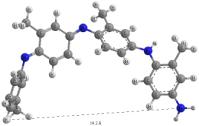1 Savita, P.; Sathyanarayana, D. N. Synth. Met. 2004, 145,113.  2 Savita, P.; Sathyanarayana, D. N. J. Polym. Sci. Part A: Polym. Chem. 2005, 43, 3040. 2 Savita, P.; Sathyanarayana, D. N. J. Polym. Sci. Part A: Polym. Chem. 2005, 43, 3040.  3 Sulimenko, T.; Stejskal, J.; Prokes, J. J. Colloid Interface Sci. 2001, 236, 328. 3 Sulimenko, T.; Stejskal, J.; Prokes, J. J. Colloid Interface Sci. 2001, 236, 328.  4 Ichinohe, D.; Muranaka, T.; Sasaki, T.; Kobayashi, M.; Kise, H. J. Polym. Sci. Part A: Polym. Chem. 1998, 36,2593. 4 Ichinohe, D.; Muranaka, T.; Sasaki, T.; Kobayashi, M.; Kise, H. J. Polym. Sci. Part A: Polym. Chem. 1998, 36,2593.  5 Borole, D.; Kapadi, U. R.; Mahulikar, P. P.; Hundiwale, D. G. Polym. Adv. Technol. 2004, 15, 306. 5 Borole, D.; Kapadi, U. R.; Mahulikar, P. P.; Hundiwale, D. G. Polym. Adv. Technol. 2004, 15, 306.  6 Elia, L. F. D.; Ortiz, R. L.; Marquez, O. P.; Marquez, J.; Martinez, Y. J. Electrochem. Soc. 2001, 148, C297.7 Sivakkumar, S. R.; Saraswathi, R. J. Appl. Electrochem.2004, 34, 1147. 6 Elia, L. F. D.; Ortiz, R. L.; Marquez, O. P.; Marquez, J.; Martinez, Y. J. Electrochem. Soc. 2001, 148, C297.7 Sivakkumar, S. R.; Saraswathi, R. J. Appl. Electrochem.2004, 34, 1147.  8 Zhang, G.-R.; Xu, C.-T.; Zhang, A.-J.; Chen, L.; Lu, J. X. Acta Chim. Sinica 2008, 66, 376 (in Chinese). (张贵荣, 徐承天, 张爱健, 陈丽, 陆嘉星, 化学学报,2008, 66, 376.)9 Zhang, G.-R.; Zhang, J.-B.; Xiao, L.-P; Zhao, S.-F.; Lu, J. X. Acta Chim. Sinica 2009, 67, 657 (in Chinese). (张贵荣, 张静波, 肖丽平, 赵淑凤, 陆嘉星, 化学学报,2009, 67, 657.)10 Zhang, G.-R.; Zhao, S.-F.; Liu, X.; Liu, X.-L.; Luo, Y.-L.; Lu, J. X. Acta Chim. Sinica 2010, 68, 1063 (in Chinese). (张贵荣, 赵淑凤, 刘晓, 刘秀丽, 罗艳玲, 陆嘉星, 化学 学报, 2010, 68, 1063.)11 Bilal, S.; Holze, R. Electrochim. Acta 2007, 52, 5346. 8 Zhang, G.-R.; Xu, C.-T.; Zhang, A.-J.; Chen, L.; Lu, J. X. Acta Chim. Sinica 2008, 66, 376 (in Chinese). (张贵荣, 徐承天, 张爱健, 陈丽, 陆嘉星, 化学学报,2008, 66, 376.)9 Zhang, G.-R.; Zhang, J.-B.; Xiao, L.-P; Zhao, S.-F.; Lu, J. X. Acta Chim. Sinica 2009, 67, 657 (in Chinese). (张贵荣, 张静波, 肖丽平, 赵淑凤, 陆嘉星, 化学学报,2009, 67, 657.)10 Zhang, G.-R.; Zhao, S.-F.; Liu, X.; Liu, X.-L.; Luo, Y.-L.; Lu, J. X. Acta Chim. Sinica 2010, 68, 1063 (in Chinese). (张贵荣, 赵淑凤, 刘晓, 刘秀丽, 罗艳玲, 陆嘉星, 化学 学报, 2010, 68, 1063.)11 Bilal, S.; Holze, R. Electrochim. Acta 2007, 52, 5346.  12 Kumar, D. Eur. Polym. J. 2001, 37, 1721. 12 Kumar, D. Eur. Polym. J. 2001, 37, 1721.  13 Rao, P. S.; Subrahmanya, S.; Sathyanarayana, D. N. Synth. Met. 2002, 128, 311. 13 Rao, P. S.; Subrahmanya, S.; Sathyanarayana, D. N. Synth. Met. 2002, 128, 311.  14 Karatchevtseva, I.; Zhang, Z.; Hana, J.; Luca, V. Chem. Mater. 2006, 18, 4908. 14 Karatchevtseva, I.; Zhang, Z.; Hana, J.; Luca, V. Chem. Mater. 2006, 18, 4908.  15 Kinyanjui, J. M.; Wijeratne, N. R.; Hanks, J.; Hatchett, D. W. Electrochim. Acta 2006, 51, 2825. 15 Kinyanjui, J. M.; Wijeratne, N. R.; Hanks, J.; Hatchett, D. W. Electrochim. Acta 2006, 51, 2825.  16 Borole, D. D.; Kapadi, U. R.; Mahulikar, P. P.; Hundiwale, D. G. Mater. Lett. 2006, 60, 2447. 16 Borole, D. D.; Kapadi, U. R.; Mahulikar, P. P.; Hundiwale, D. G. Mater. Lett. 2006, 60, 2447.  17 Zhang, G. R.; Zhang, A. J.; Wang, H.; Liu, X. L.; Lu, J.-X. Acta Polym. Sinica 2008, (1), 47 (in Chinese). (张贵荣, 张爱健, 王欢, 刘秀丽, 陆嘉星, 高分子学报,2008, (1), 47.) 17 Zhang, G. R.; Zhang, A. J.; Wang, H.; Liu, X. L.; Lu, J.-X. Acta Polym. Sinica 2008, (1), 47 (in Chinese). (张贵荣, 张爱健, 王欢, 刘秀丽, 陆嘉星, 高分子学报,2008, (1), 47.)  18 Shreepathi, S.; Holze, R. Langmuir 2006, 22, 5196. 18 Shreepathi, S.; Holze, R. Langmuir 2006, 22, 5196.  19 Cordova, R.; Delvalle, M. A.; Arratia, A.; Gomez, H.; Schrebler, R. J. Electroanal. Chem. 1994, 377, 75. 19 Cordova, R.; Delvalle, M. A.; Arratia, A.; Gomez, H.; Schrebler, R. J. Electroanal. Chem. 1994, 377, 75.  20 Scharifker, B.; Hills, G. Electrochim. Acta 1983, 28, 879. 20 Scharifker, B.; Hills, G. Electrochim. Acta 1983, 28, 879.  21 Mandic, Z.; Duic, L.; Kovacicek, F. Electrochim. Acta1997, 42, 1389. 21 Mandic, Z.; Duic, L.; Kovacicek, F. Electrochim. Acta1997, 42, 1389.  22 Hwang, B. J.; Santhanam, R.; Wu, C. R.; Tsai, Y. W. J. Solid State Electrochem. 2001, 5, 280. 22 Hwang, B. J.; Santhanam, R.; Wu, C. R.; Tsai, Y. W. J. Solid State Electrochem. 2001, 5, 280.  23 Kwon, O.; McKee, M. L. J. Phys. Chem. B 2000, 104, 1686. 23 Kwon, O.; McKee, M. L. J. Phys. Chem. B 2000, 104, 1686.  24 Lim, S. L.; Tan, K. L.; Kang, E. T.; Chin, W. S. J. Chem. Phys. 2000, 112, 10648.25 Mishra, A. K.; Tandon, P. J. Phys. Chem. B 2009, 113,9702. 24 Lim, S. L.; Tan, K. L.; Kang, E. T.; Chin, W. S. J. Chem. Phys. 2000, 112, 10648.25 Mishra, A. K.; Tandon, P. J. Phys. Chem. B 2009, 113,9702.  |
